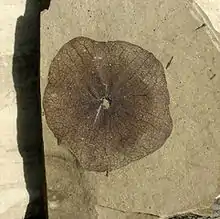Florissantia
Florissantia is an extinct species of flowering plants from prehistoric western North America, from the Eocene to Oligocene Periods of the (56 to 23 million years ago)
| Florissantia | |
|---|---|
 | |
| Florissantia sp. flower | |
| Scientific classification | |
| Kingdom: | Plantae |
| Clade: | Tracheophytes |
| Clade: | Angiosperms |
| Clade: | Eudicots |
| Clade: | Rosids |
| Order: | Malvales |
| Family: | Malvaceae |
| Subfamily: | Sterculioideae |
| Genus: | †Florissantia Manchester |
| Species | |
| |
| Synonyms[1] | |
|
Porana speirii Lesquereux | |
Fossils
The plant is known from compression fossils of its flowers, fruits, and pollen.
Fossilized remains have been found in several localities, including fossil beds in British Columbia, Washington state, Oregon, and Colorado.[1]
References
- Manchester, S. R. (1992). "Flowers, fruits and pollen of Florissantia, an extinct malvalean genus from the Eocene and Oligocene of western North America". American Journal of Botany. 79 (9): 996–1008. doi:10.2307/2444909. JSTOR 2444909.
This article is issued from Wikipedia. The text is licensed under Creative Commons - Attribution - Sharealike. Additional terms may apply for the media files.